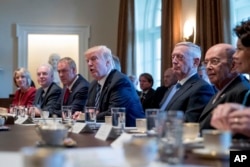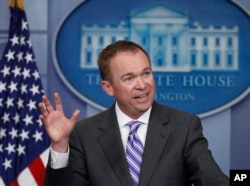U.S. President Donald Trump on Monday signed an executive order to begin the process of reorganizing the federal government, something he called "long overdue."
During his first Cabinet meeting earlier in the day, the president said the purpose of the directive is to make government "less wasteful and more productive."
But critics previously have expressed concern that the process could lead to a compromise of government functions, especially in public health and national security.
Just prior to the signing in the Oval Office later, the president declared this "a major step to making the federal government efficient, effective and accountable to the people."
The order requires a self-examination by every executive department and agency to identify wasteful spending and how services can be improved.
Asked if there's a numeric goal or a mandated savings of a certain amount of money, Press Secretary Sean Spicer, at a news conference earlier in the day, replied, "there's no set number that we're driving down to."
Rather, the goal, he said, is for agencies to look at themselves and their programs to determine if they are "bloated or duplicative or, frankly, just outdated or in need of technological advances."
According to Trump at the signing ceremony, there is "duplication and redundancy everywhere" in the federal government, with "billions and billions" of dollars being wasted on activities.
The director of the Office of Management and Budget, Mick Mulvaney, will oversee the process, working with experts inside and outside of the federal government "and seeking input from the American people themselves," the president said.
"We will then work with Congress to implement these recommendations," he added.
Cato Institute economist Chris Edwards, who edits an online guide to government downsizing, said of the executive order: "It can't hurt. … It's a good start."
As for government entities being tasked with looking for costs savings internally, Edwards told VOA that is a good idea because "it's often difficult for lawmakers to determine what's going on in agencies."
Achieving big savings in the federal budget, according to Edwards, will only occur after lawmakers identify whole programs that can be eliminated or placed in the hands of the individual 50 states.
"It'll ultimately be up to Congress what they want to cut," Edwards said.
Monday's executive order comes after one issued January 30 to reduce regulations and control regulatory costs.
The president's chief strategist in the White House, Steve Bannon, has called for a "deconstruction of the administrative state," and last month the president declared that the federal government would have to "do more with less."













